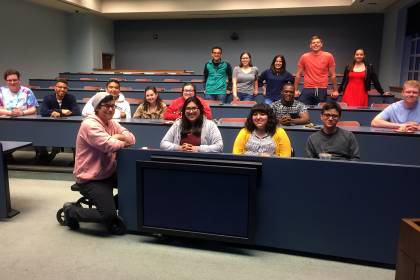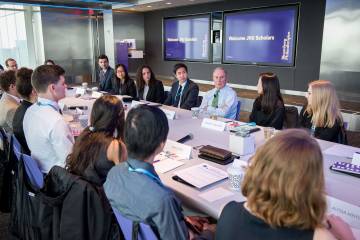Attending college can feel a lot like traveling to a foreign land. Even a hometown campus will have its own set of customs, rituals, and lingo that might puzzle a newcomer.
Students whose parents or other family members are themselves college graduates can look to their loved ones for guidance in navigating this transition. But for first-generation students or those from limited-income backgrounds—FLI students, in Johns Hopkins University parlance—adapting to campus life can be a challenging and at times isolating experience. Both nationally and at Johns Hopkins, FLI students are statistically less likely to interact with faculty, seek assistance when they need it, or easily find a social niche than non-FLI students.
"Like many of my FLI peers, I grew up an independent and determined student," says Elizabeth Aguirre, a first-year and first-generation Hopkins student studying computer engineering. "I employed these characteristics in order to finish my first semester at Hopkins as best I could—sacrificing sleep while attempting to live a balanced life.
"I realize how many times I didn't ask for help when I needed to," Aguirre adds, "partly because I wasn't aware of all the resources."
The same is true for many FLI students, a growing concern as the number of FLI students attending university continues to increase across the country.
At Johns Hopkins, 47.8% of undergraduate students are of limited income and 24.4% are first-generation—slightly higher than the national average of 20%. Overall, 18.3% of students are both first-generation and limited-income.
Last year's incoming class, the Class of 2022, saw a 2% increase over the previous year in the number of first-generation students, highlighting both the university's efforts to recruit the most talented scholars regardless of their family history or ability to pay and also the growing need to provide support for these students once they arrive.

Image caption: Johns Hopkins students participate in an FLI Network event
"Nationally, FLI students' graduation rates are significantly lower," says Irene Ferguson, director of student enrichment programs at the Center for Student Success, or CSS.
Likewise, FLI students who do graduate often report lower levels of satisfaction with their collegiate experience than non-FLI students.
Michael R. Bloomberg's recent, historic gift of $1.8 billion in support of financial aid will radically expand student access and mobility, ensuring that a Hopkins education is within reach for qualified, high-achieving students regardless of their ability to pay. The gift will also enable the university to enhance the resources it provides FLI students not only during the admissions and acceptance process, but also throughout their time as undergraduates.
In the fall of 2016, Ferguson and colleagues across the university formed a working group that included student affairs staff, academic affairs staff, faculty, and students to explore ways of better serving Johns Hopkins' FLI population. Two existing programs—JUMP, which launched in 2001, and Hop-In, which debuted in 2015, were serving no more than 25% of FLI students, Ferguson said.
Hop-In provides an annual cohort of 40 FLI students with a broad range of support, beginning with a summer program for incoming first-year students and continuing through to graduation with mentoring, financial literacy programs, career guidance, and more. JUMP is a similar program tailored to underrepresented populations—including ethnic and racial minorities as well as FLI students of any race—who are interested in pursuing careers in medicine and other health professions.
While both Hop-In and JUMP have proven successful, providing hundreds of participating students with connections to faculty and campus resources, Ferguson and the working group saw a need for programming with a broader reach.
Their work resulted in last summer's launch of the FLI Network, an initiative that seeks to cultivate a sense of belonging, inclusion, encouragement, and resilience among FLI students by connecting them with other FLI students as well as FLI faculty, staff, alumni, and allies in the Johns Hopkins community. The network currently stands at 51 undergraduate and graduate students, seven alumni, 34 faculty, and 44 staff members, including departmental directors, academic advisors, and associate deans, among others.
"So many students fall through the cracks because they don't get specifically invited to the cohort programs or they fill up," says Melissa Eustache, a first-generation junior studying neuroscience who has worked closely with Ferguson on FLI support programming. "They don't know about the resources that are available to all students. The FLI Network is an effort to extend the reach of the CSS to students who may not be aware of services or don't think services apply to them."
Eustache is particularly focused on breaking down stereotypes and assumptions about FLI students that often discourage students from seeking the help they need.
"I once had a conversation with someone who didn't think they identified as first-generation because they're white," she says. "We have to make sure we affirm the fact that FLI students aren't all of a certain ethnicity, minority, or other group of people."
Ferguson agrees: "It's a culture shift, and it takes time to do that, but there's an openness to such a shift," she says. "More people are becoming aware, and we are dispelling those myths about this group. They wouldn't be accepted if they weren't capable of doing the work."
The FLI Network is just one component of the university's efforts to educate the broader community on the concerns—and accomplishments—of its FLI population. In September, Ferguson's team rolled out the "I'm First" campaign, which increased the visibility of faculty and staff members who were themselves FLI college students by providing them with "I'm First" decals to display on their office doors, windows, or other prominent places. Almost 1,000 decals have been distributed to date.
"As we did events to give them away," Ferguson recalls, "we were excited to learn how many faculty and staff are also first-generation and connect with them. And the students were glad to see it acknowledged."
The university has also established a FLI Student Advisory Committee, which is led by the students of the FLI Network's executive board and empowers them to assist in the governance of the network. Committee members are also given the opportunity to connect with peers at other highly-selective institutions through the annual 1vyG Conference, where hundreds of students, administrators, and organizations gather to build community and work to improve FLI support systems on campuses across the nation.
Perhaps the greatest success of these programs is the willingness and enthusiasm that the students have for passing the benefits on to future Blue Jays.
"First- and second-year FLI students I've spoken to didn't know they didn't have to be in Hop-In to use CSS resources," Eustache says. "It's important to make sure they have that support in their face on their first day. Retention could increase with a little extra effort to make FLI services more accessible and widely known."
Adds Aguirre: "Currently, what gives me the most satisfaction is meeting prospective FLI students and sharing my experience with them. Planning and seeing new initiatives come to life for the future of this community on campus makes me hopeful to see Hopkins continue to move in the right direction."
Posted in Student Life
Tagged homewood student affairs, undergraduate education, hop-in, center for student success











